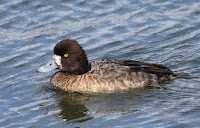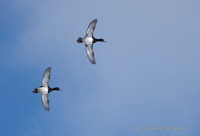GREATER SCAUP
GREATER SCAUP (Aythya marila) – (See images below)
DESCRIPTION: The Greater scaup is a diving duck of medium size. In breeding plumage the male has a black head with iridescent dark green, and a black breast. The sides are white and the back is finely striated black and white. The under parts are white. The female has a dark brown head with some white around the bill, and a brown body. The eyes are yellow and the bill is blue in both sexes. The legs are grey. The length of this duck is approximately 20 inches (50 cm).
VOICE: https://www.xeno-canto.org/species/Aythya-marila
NAME: The name ‘Scaup’ would origin from Sottish ‘scalp’ and refers to a ledge in the water, where these ducks gather to feed. ‘Greater’ implies that there’s also a ‘Lesser Scaup’. The Latin genus name ‘Aythya’ comes from Greek and refers to a ‘kind of waterbird’, and the species name ‘marila’ means ‘charcoal’ in Greek, in reference to the black color in the drake.
HABITAT: In the summer, wet tundra and northern lakes. In the winter, along the coasts and inland lakes.
DIET: The greater scaup feeds on crustaceans, insects and plants.
NESTING: Most of these ducks breed in Alaska and form colonies, and build their nests on lake islands. An average of seven light beige eggs are laid, and the mother alone incubates them and cares for the ducklings.
DISTRIBUTION: The greater scaup breeds in the Arctic around the globe. Their wintering range includes both coasts of North America, the coasts of Europe, the Caspian and the Black seas, the coasts of Asia and also inland lakes such as the Great Lakes. This duck is a rare winter visitor on Hawaii.
DISTRIBUTION MAP: https://en.wikipedia.org/wiki/Greater_scaup#/media/File:The_GS_range_map.jpg
ON PEI: The Greater Scaup is common on Prince Edward Island in the winter, where it will spend the whole season if it can find enough food in unfrozen bodies of water.
CONSERVATION: The greater scaup is a popular game bird. Its population is threatened by habitat loss and degradation due to contaminants in the water from where it feeds along its migratory routes. Females are becoming less fertile and it is thought that it might be related to their diet of zebra mussels in the Great Lakes, which are contaminated with selenium. In spite of these issues the species is still listed as ‘least concern’.
NOTES: This bird forms large flocks on the water called ‘rafts’, where they can number in the thousands.
SIMILAR SPECIES: Lesser Scaup, Tufted Duck, Ring-necked Duck – Here’s an article to help distinguish the lesser from the greater scaup: https://www.thespruce.com/greater-scaup-or-lesser-scaup-387345
REFERENCES: https://en.wikipedia.org/wiki/Greater_scaup
https://www.allaboutbirds.org/guide/Greater_Scaup/id
http://www.birdweb.org/birdweb/bird/greater_scaup
http://www.ducks.org/hunting/waterfowl-id/greater-scaup
http://www.arkive.org/greater-scaup/aythya-marila/
DESCRIPTION: The Greater scaup is a diving duck of medium size. In breeding plumage the male has a black head with iridescent dark green, and a black breast. The sides are white and the back is finely striated black and white. The under parts are white. The female has a dark brown head with some white around the bill, and a brown body. The eyes are yellow and the bill is blue in both sexes. The legs are grey. The length of this duck is approximately 20 inches (50 cm).
VOICE: https://www.xeno-canto.org/species/Aythya-marila
NAME: The name ‘Scaup’ would origin from Sottish ‘scalp’ and refers to a ledge in the water, where these ducks gather to feed. ‘Greater’ implies that there’s also a ‘Lesser Scaup’. The Latin genus name ‘Aythya’ comes from Greek and refers to a ‘kind of waterbird’, and the species name ‘marila’ means ‘charcoal’ in Greek, in reference to the black color in the drake.
HABITAT: In the summer, wet tundra and northern lakes. In the winter, along the coasts and inland lakes.
DIET: The greater scaup feeds on crustaceans, insects and plants.
NESTING: Most of these ducks breed in Alaska and form colonies, and build their nests on lake islands. An average of seven light beige eggs are laid, and the mother alone incubates them and cares for the ducklings.
DISTRIBUTION: The greater scaup breeds in the Arctic around the globe. Their wintering range includes both coasts of North America, the coasts of Europe, the Caspian and the Black seas, the coasts of Asia and also inland lakes such as the Great Lakes. This duck is a rare winter visitor on Hawaii.
DISTRIBUTION MAP: https://en.wikipedia.org/wiki/Greater_scaup#/media/File:The_GS_range_map.jpg
ON PEI: The Greater Scaup is common on Prince Edward Island in the winter, where it will spend the whole season if it can find enough food in unfrozen bodies of water.
CONSERVATION: The greater scaup is a popular game bird. Its population is threatened by habitat loss and degradation due to contaminants in the water from where it feeds along its migratory routes. Females are becoming less fertile and it is thought that it might be related to their diet of zebra mussels in the Great Lakes, which are contaminated with selenium. In spite of these issues the species is still listed as ‘least concern’.
NOTES: This bird forms large flocks on the water called ‘rafts’, where they can number in the thousands.
SIMILAR SPECIES: Lesser Scaup, Tufted Duck, Ring-necked Duck – Here’s an article to help distinguish the lesser from the greater scaup: https://www.thespruce.com/greater-scaup-or-lesser-scaup-387345
REFERENCES: https://en.wikipedia.org/wiki/Greater_scaup
https://www.allaboutbirds.org/guide/Greater_Scaup/id
http://www.birdweb.org/birdweb/bird/greater_scaup
http://www.ducks.org/hunting/waterfowl-id/greater-scaup
http://www.arkive.org/greater-scaup/aythya-marila/
 |
| Greater scaup drake, Lake Merritt, CA by Calibas, Mar. 19, 2007 |
 |
| Greater scaup female, by Basar |
 |
| Greater scaup in flight, Rustico, PEI, Canada, by Matt Beardsley |
 |
| Greater scaup male, PEI, Roberta Palmer |
 |
| Greater scaups in flight, Matt Beardsley |